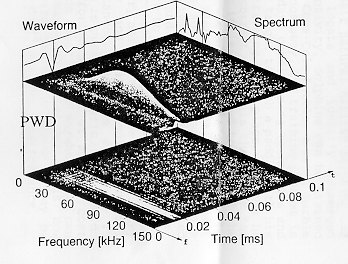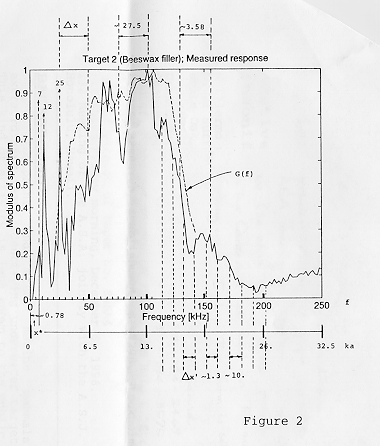Guillermo C. Gaunaurd - Gaunaurd@oasys.dt.navy.mil
Donald Brill
Hanson Huang
Naval Surface Warfare Center
Carderock Division
Code 684
White Oak, Silver Spring, MD 20903-56430
Patrick W.B. Moore
Naval Command & Control Ocean Systems Center, NRaD
San Diego, CA 92152
Hans C. Strifors
National Defense Research Establishment, S-17290
Stockholm, Sweden
Popular Version of Paper 5aSA4
Presented Friday morning 6 December 1996
3rd Joint Meeting of the Acoustical Society of America and the Acoustical Society of Japan
Honolulu, Hawaii
Embargoed until 6 December 1996
Background
Dolphins and other marine mammals can perform extraordinary feats identifying underwater targets acoustically. This kind of activity is less known to the public than other more athletic ones seen in places like SEAWORLD or MARINELAND in which the animals jump through hoops or splash the spectators in the front row of an Aquatheater. In their natural habitat dolphins use their "echolocation clicks" to locate and identify submerged objects, particularly fish. In captivity, dolphins can be trained to identify bodies such as, say, a Coca-Cola bottle, a metal marble or a submerged mine, quite a distance away. The training process is somewhat involved, but using standard conditioning techniques and food reinforcements, the animal is taught to push a paddle with his noise in the water space where the training takes place, whenever he "sees" the "correct" object. The correct object is the one he has been trained to identify whenever it is presented to him. If the "correct" object is presented and the animal tells us it is so by pushing the paddle, he is rewarded with fish. If the "wrong" object is presented and the animal does not push the paddle - also a correct answer - he is also rewarded. Quite sophisticated experiments have been designed -- and this is an art in itself -- in which the animal can communicate to us his consistently correct choices, on the basis of "yes or no" answers. These tests have amply demonstrated the extraordinary ability of these animals. They can distinguish between shapes and quite similar material compositions at very large distances. They can easily do it blindfolded, so the discrimination is purely acoustic. They also do it consistently, immediately, effortlessly and at minimal cost (i.e., a fish). There is no man-made sonar system anywhere that can begin to match this type of performance. The great mystery is: How do they do it? If this answer were completely known it may be possible to some day mechanically duplicate their performance.
Recent Analysis of Dolphin Echoes
Many dolphin-emitted pulses which were reflected from various elastic shells with different internal fillers were collected in a large open bay test site in Kaneohe, Hawaii. (See Figure 1). Special instrumentation recorded the emitted clicks and also the echoes returned when the shells were interrogated by a trained dolphin. All these signals formed a database that we analyzed with various signal-processing techniques. The signatures were examined as functions of time, and of frequency, as is traditionally done, and also in a more advanced way, as joint functions of time and frequency using certain "Wigner-type" distributions. [Ref.1]

Fig. 1. Experimental set-up for dolphin training, testing, monitoring and data collection in Kaneohe Bay, HI.
Our echo analysis capitalizes on certain fundamental resonance principles which show which echo features contain information about the size, shape, and composition of both the shell and its filler. Having deciphered this "code" contained within the signatures, we can extract the identifying characteristics of each shell. We suggest, and would like to believe, that in the same way that we can do this, so can the dolphin. This analysis may thus provide the fundamental physical explanation of the animal's amazing target-ID feats, upon which they base their consistently correct choices. We not only studied the measured echoes in the database but also we generated a computational model to numerically predict these same echoes. This predictive model is based on an elasticity theory formulation to describe the shell motions, combined with the equations of linear acoustics for the simulation of the echo signals the animal receives from the shells in response to his "pingings." Such predictive model is possible because the targets are relatively simple (i.e., elongated, metal, cylindrical shells with fillers, vertically suspended in front of the animal, a distance away.) The predictions and measurements, although not identical replicas of each other, are in general agreement and, most important, they both reveal the same identifying features in the time or frequency domains, and also in the most informative joint "time-frequency" domain. Although the identifying clues are present in all the above mentioned displays, they are simpler to analyze and to interpret in the "Wigner space" of the joint time-frequency domain. A signal processing technique is "better" than another if it gets more and cheaper mileage out of the same data.
Overview of Code-Breaking Details
In very general terms, since it is hard to give these details in lay-language and in brief space, there are certain peaks and certain spacings in-between peaks in the echo-signal-in any of its possible displays - that can be directly associated with the size, shape and composition of the shell and its filler. Analysis of these uniformly occurring "features" immediately quantify the shell properties. These have been thoroughly explained from fundamental principles of scattering theory for elastic scatterers. Even when several interacting targets are present, the identification can be achieved, as well as the determination of the separation in-between them. [Ref.2]. The presence or absence of these peaks and spacings in the signals characterize the object (or objects). The process is so simple that it hardly requires any calculation. With a bit of training, a human can just look at a returned echo and tell the type of object that returned it, even without a fish reward! Of course, one should know what to look for in the signal. We believe the dolphins do the same, even better than humans. The joint time-frequency representation of the echoes is the most informative. It provides the complete time-evolution of the identifying resonance spectrum. This is not achievable by earlier conventional means. However, there are many ways to obtain a joint time-frequency representation of an echo by using the arsenal of "Wigner-type" distributions in current existence. The determination of which one (or ones) are most advantageous is still under present study. Additional information on "Wigner-type" distributions and their applications to target-ID, in general, have recently appeared. [Ref.3]. Finally, in an experiment with various identical shells containing different internal fillers, the dolphin correctly discriminated between the fillers inside each shell, even when they were all quite similar in composition, presumably using the peaks and/or spacings observable in the echoes that we described above. The Naval applications of such remarkable animal sonar feats are easy to imagine. The "fingerprints" of the target appear in its echo-signature like in a macroscopic type of Spectroscopy, and it is a question of extracting them and connecting them to the physical properties of the target, to acoustically classify it. Our approach seems amenable to automation in a straightforward fashion, and it can be applied to any sonar echo, not necessarily dolphin generated.

Fig. 2. Measured frequency response of a long cylindrical aluminum shell filled with beeswax interrogated
by a dolphin click.

Fig 3. Pseudo-Wigner Distribution (PWD) of the measured echo from the beeswax-filled cylindrical shell
interrogated by the dolphin click. "Spacings" (delta)x, (delta)x(prime), (delta)t and (delta)t(prime) are
observed.
References
1) T.A. Claasen and W.F. Mecklenbrauker, "The Wigner distribution: A tool for time-frequency signal analysis", Phillips Journal of Research, Vol. 35, Parts 1,2, and 3, pp. 217-250, 276-300, and 372-389, (1980).
2) G.C. Gaunaurd and H. Huang, "Remote target identification of pairs of submerged elastic shells by active sonar," Inverse Problems in Engineering Journal, Vol. 3, (#3), pp. 67-78, (1996).
3) G.C. Gaunaurd and H.C. Strifors, "Signal analysis by means of time-frequency (Wigner-type) distributions -- Applications to Sonar and Radar Echoes," Proceedings of the IEEE, Vol. 84, (#(), Special Issue on: Time-Frequency Analysis, pp. 1231-1249, (Invited, 1996).